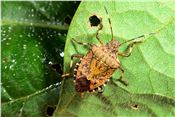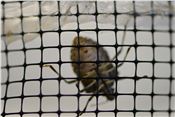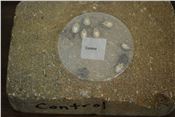Brown Marmorated Stink Bug On The Move
DR. RIC BESSIN AND DR. MIKE POTTER
LEXINGTON, KY.
While monitoring vegetable and soybean fields in the Lexington area I have noticed that the number of brown marmorated stink bug (BMSB) adults has dropped off as the numbers of nymphs on these crops has remained constant. Last year, BMSB began to gather on the sides of homes the first week in September. This makes me believe that BMSB is changing its behavior from plant feeding to begin searching for overwintering sites, possibly your home. I did spot 15 BMSB on the side of my house on Saturday. So, over the next several weeks we should expect BMSB to gather on buildings in search of suitable overwintering sites. Once inside buildings they will remain active until mid-spring.
In addition to BMSB, there are several other insect invaders that enter buildings, including boxelder bug, multicolor Asian lady beetle, cluster flies, and western conifer seed bug. But BMSB has the potential to gather in larger numbers in homes than these other pests. Besides just being a nuisance, the nearly ¾-inch BMSB releases a cilantro-like odor when disturbed and may feed on houseplants during winter months.
Managing Household Invaders
With BMSB, as with other household invaders, the best strategy is prevention: keep them out of your home. Buildings that have had previous problems may be more likely to have future problems. Seal and screen (1/6-inch mesh screen or finer; see Figure 2) entry points to the attics, around doors and windows, and to basements and crawl spaces to limit numbers that enter. Topping chimneys with screens or caps can also help. Dr. Mike Potter lists a number of steps that can be taken to pest proof your home in How to Pest-proof Your Home (Entfact 641).
Indoors during the winter, BMSB try to congregate in various places inside structures. This can be in chimneys, closets, window air conditioning units, attics, behind books on a shelf, etc. The best way to remove them once they gain entry is with a vacuum. A knee-high stocking can be used in the suction tube of the vacuum to reduce the number of bags needed. The stink bugs can be disposed of into soapy water. Various types of light baited/funnel traps and soapy water traps can be used to remove them from dark areas in a home.
UK Insecticide Barrier Study
Last fall, Mike Potter and I conducted an insecticide barrier study with three pyrethroid insecticides available to pest control operators. Bricks were treated with a pyrethroid or water (control) and allowed to air dry for 24 hours prior to the study. Stink bugs were confined under petri dish lids for either 5 minutes or 24 hours of exposure (Figure 3).
After 24 hours BMSB mortality was assessed. With 24-hour exposure on a treated brick surface there was 100 percent mortality, and a 5-minute exposure resulted in over 60 percent control with each of the pyrethroid insecticides. The new labeling with pyrethroid barrier sprays is more restrictive to prevent contamination of runoff water, but treatment of cracks and crevices (with a narrow band of spray) and under eaves that are protected from the rain, is still possible. Read and follow all label restrictions carefully.∆
DR. RIC BESSIN AND DR. MIKE POTTER: Extension Entomologists, University of Kentucky

Brown Marmorated Stink Bug on the Move

Figure 2. A lab study at UK found ¼-inch screen to be too wide to exclude BMSB.
(Photo: Ric Bessin, UK)

Figure 3. Brown marmorated stink bugs (BMSB) were confined under a petri dish lid on
treated bricks for either 5 minutes or 24 hours.
(Photo: Ric Bessin)